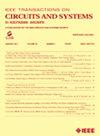开关电阻自适应门偏置技术优化CMOS整流器正反导通
IF 4.9
2区 工程技术
Q2 ENGINEERING, ELECTRICAL & ELECTRONIC
IEEE Transactions on Circuits and Systems II: Express Briefs
Pub Date : 2025-06-10
DOI:10.1109/TCSII.2025.3578345
引用次数: 0
摘要
本简报提出了一种开关作为电阻的自适应门偏置技术,该技术在900 MHz单级交叉耦合整流器中实现,用于物联网和WSN应用。该方法采用NMOS开关作为阻性元件(RRES),由CMOS逆变器的矩形信号控制。这种配置自适应地在反向(正向)传导阶段启用(禁用)NMOS开关,并自适应地提供栅极偏置,导致正向电荷守恒,反向电荷减轻。因此,输出端电荷积累越高,输出功率越强。该电路在输入功率(PIN)为-21 dBm时,通过100 k ω负载,峰值功率转换效率(PCE)达到84.3%。该电路还实现了25 dB DR, PCE超过20%。该整流器的芯片面积仅为0.0105 mm2,在100 k ω负载下可实现25 dB的最宽PDR和-18 dBm的灵敏度。与其他先进的整流器相比,该方案在PDR和PCE方面表现出更高的性能。本文章由计算机程序翻译,如有差异,请以英文原文为准。
A Switch-as-Resistor Self-Adaptive Gate-Biasing Technique for Optimized Forward and Reverse Conduction in a CMOS Rectifier
This brief proposes a switch-as-resistor self-adaptive gate-biasing technique implemented in a 900 MHz single-stage cross-coupled rectifier for IoT and WSN applications. The proposed method employs NMOS switches as the resistive component (RRES), which are controlled by a rectangular signal from a CMOS inverter. This configuration adaptively enables (disables) the NMOS switches during reverse (forward) conduction phases, and self-adaptively provides gate-biasing, resulting in conserved forward charge with mitigated reverse charge. As a result, the output power is enhanced with higher charge accumulation at the output terminal. The circuit gives a measured result of 84.3% in peak power conversion efficiency (PCE) at an input power (PIN) of –21 dBm through a 100 k $\Omega $ load. The proposed circuit also achieves a 25 dB DR with a PCE of over 20%. With a compact chip area of 0.0105 mm2, the rectifier achieves the widest PDR of 25 dB and a sensitivity of –18 dBm under a 100 k $\Omega $ load. Compared to other state-of-the-art rectifiers, the proposed scheme demonstrates higher performance in terms of PDR and PCE.
求助全文
通过发布文献求助,成功后即可免费获取论文全文。
去求助
来源期刊
CiteScore
7.90
自引率
20.50%
发文量
883
审稿时长
3.0 months
期刊介绍:
TCAS II publishes brief papers in the field specified by the theory, analysis, design, and practical implementations of circuits, and the application of circuit techniques to systems and to signal processing. Included is the whole spectrum from basic scientific theory to industrial applications. The field of interest covered includes:
Circuits: Analog, Digital and Mixed Signal Circuits and Systems
Nonlinear Circuits and Systems, Integrated Sensors, MEMS and Systems on Chip, Nanoscale Circuits and Systems, Optoelectronic
Circuits and Systems, Power Electronics and Systems
Software for Analog-and-Logic Circuits and Systems
Control aspects of Circuits and Systems.

 求助内容:
求助内容: 应助结果提醒方式:
应助结果提醒方式:


